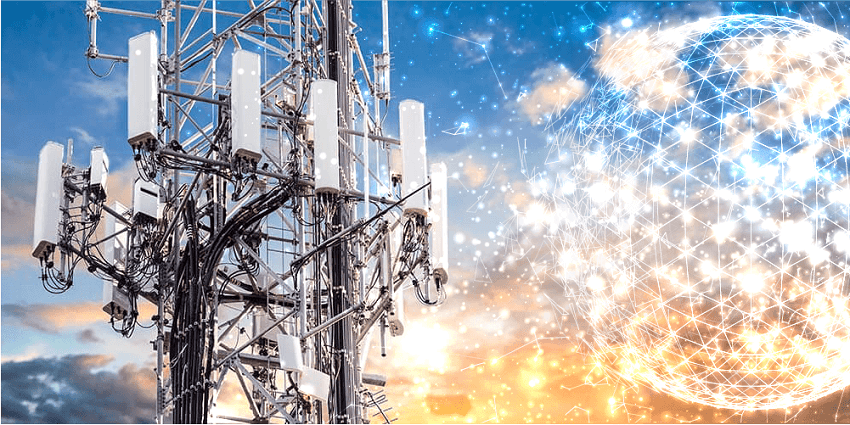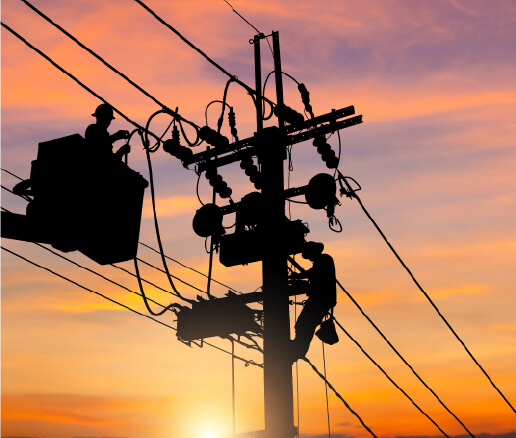by Webbing Team | July 16, 2025
For any technology, there can hardly be a more important application than protecting people’s health and lives. Cellular technology is a perfect example of this, as it powers many solutions in healthcare and emergency response. Yet there is another area where it plays a critical role: worker safety.
Although basic safety monitoring tools existed in the past, the emergence of cellular connectivity brought a major leap forward. Previously, supervisors had to rely solely on manual reporting, which meant they often wouldn’t know something was wrong, especially if workers were unaware of the danger themselves. Location tracking wasn’t possible either: even if workers carried walkie-talkies, there was no way to know where they were. Also, all safety measures were reactive, which made it difficult to prevent incidents. Cellular connectivity changed all of that.
Most importantly, it has enabled real-time communication and data transmission from many devices that are used today for monitoring workers’ health and wellbeing. Never before have enterprises been able to continuously track the physical condition of every employee, detect exposure to danger as it happens, and respond proactively, before a health incident occurs or a safety policy violation leads to serious consequences. This is especially critical for industries like construction, energy, mining or oil and gas, where workers oftentimes must perform their job in remote locations where wired networks are unavailable and traditional monitoring methods fall short.
Additionally, cellular connectivity allowed for the automation of many dangerous tasks that used to be performed by workers, such as inspections that are now done by drones or robots. Inspecting electricity grids, cable tunnels, HVDC converter stations and LNG facilities, they save time and manpower, and enhance worker safety.
Let’s take a look at the use cases that show how cellular connectivity supports safety systems and improves response time:

Lone Worker Protection
In construction, mining, oil and gas, forestry and agriculture, cellular connectivity can help ensure the safety of employees working alone in remote or hazardous areas without direct supervision. Cellular connectivity is essential for them because Wi-Fi or wired networks are typically unavailable in these locations. Cellular networks enable continuous real-time tracking and, if an emergency occurs, instant alert delivery along with GPS coordinates, so the rescue team can locate and assist the worker quickly.
In one of the most recent examples, Great River Energy conducted a pilot program deploying cellular-enabled smartwatches with fall‑detection and emergency SOS features for field technicians working alone. During the pilot, one technician fell into a ditch while inspecting utility infrastructure, and the watch detected the fall and automatically sent out an alert.
Health and Fatigue Monitoring
Reliable connectivity and quick data transmission can be a matter of life and death – particularly for workers engaged in manual labor and exposed to environmental heat, like in construction or agriculture. Those working in intense-heat environments, such as outdoor job sites or fields, face serious risks of heat stress, heat exhaustion, or heat stroke. Unlike heat stroke, which has clear symptoms like loss of consciousness, heat exhaustion and heat stress may not trigger an obvious emergency, but they can escalate into life-threatening conditions and result in death within minutes. According to the International Labour Organization, excessive heat causes 22.85 million occupational injuries, and the loss of 18,970 workers’ lives each year.
Cellular connectivity is essential for workers’ health and fatigue monitoring, since it enables continuous real-time transmission of biometric data such as heart rate, body temperature, oxygen levels, or fatigue indicators from wearable sensors to centralized safety systems. When a worker shows signs of heat stress, overexertion, or events like a cardiac issue or blood pressure drop, these cellular-enabled wearable devices immediately send alerts to supervisors or emergency services, so they can intervene and either prevent the health issue or provide help promptly.

Environmental Hazard Detection
Another use case has to do with workers’ exposure to other environmental hazards. In mining, energy or oil and gas facilities, workers often encounter toxic gases, poor air quality, excessive noise, or vibration. Cellular connectivity allows to put stationary sensors that monitor conditions in a specific area literally everywhere, including remote facilities and outdoor worksites with no access to wired infrastructure. It also enables wearable devices, which, for example, may combine gas detection capabilities with fall and no-motion detection functionality, as well as SOS buttons and leverage integrated 4G/3G connectivity to connect to remote operation centers for alerts and two-way voice and text communications.
A couple of years ago, at a pipeline terminal in a rural location in Texas, a group of workers was repairing equipment, and one of them lost consciousness after inhaling hydrogen sulfide (H₂S), a highly toxic gas. However, his teammates didn’t notice, and if not for a cellular-connected wearable device that automatically triggered an alert from gas exposure, they might not have known they were in danger, too. Reliable connectivity helped save lives, ensuring immediate emergency response.

Situational Awareness and Video Surveillance
In many cases, ensuring safety requires not just monitoring workers’ wellbeing, but maintaining comprehensive situational awareness of their environment and activities. That implies equipping workers, especially first responders and security personnel, with cellular-connected devices that provide real-time voice, video, location, and health data sharing.
Firefighters and police use cellular networks to connect body cameras, push-to-talk radios, tablets and other devices that help them coordinate during critical operations. They provide stable connectivity even in disaster zones or rural areas where fixed networks are unavailable, and guarantee the bandwidth and coverage necessary for real-time video, voice, and data sharing during emergencies.
Companies also use surveillance and video analytics to enhance occupational safety and health, oftentimes as video-surveillance-as-a-service (VSaaS) packages. Along with mounted cameras and mobile surveillance units, these smart surveillance systems may include also hard hat helmet cameras or body cameras. While they stream footage over cellular networks to the cloud for real-time monitoring of unsafe practices or conditions, video analytics systems identify potential hazards, such as workers in crane operation areas or unsafe equipment use, and send alerts to supervisors. In the event of an accident, recorded footage can be reviewed to investigate what happened, help to improve safety protocols and prevent future incidents.
Smart PPE Compliance and AR Tools
Last but not least, cellular connectivity helps improve safety and ensure compliance with regulations by verifying that workers are using required safety gear. Sensor-enabled personal protective equipment (PPE) such as helmets, vests, or eyewear can automatically detect whether workers are wearing it correctly and consistently. These smart systems feed real-time data to safety management platforms, and with cellular connectivity, it can be transmitted continuously, even from remote or distributed worksites. Thanks to it, safety officers or supervisors can monitor compliance in real time without relying on manual reporting, and receive alerts if PPE is removed or malfunctions.
Cellular connectivity can also be used for augmented reality (AR) wearables, and it plays a critical role in enabling many of their core functions, such as real-time access to cloud data and remote expert support. A good example is the use of 5G AR glasses in inspection, maintenance, and training processes for aircraft landing gear systems, where they help to adhere to complex inspection protocols and improve compliance with aviation safety standards.

Connectivity Requirements for Worker Safety
While various use cases would differ in terms of connectivity demands, there are several common criteria that are important for virtually all use cases related to worker safety:
Coverage
In various industries, workers are often deployed in remote and rural areas, constantly or temporarily – say, in an oil field or during road works. But even in industrial zones close to big cities, cellular infrastructure can be limited.
Reliable coverage is critical for safety devices to maintain a constant connection to monitoring systems and supervisors. Without it, key safety features like SOS alerts or environmental hazard monitoring may fail to function properly, delaying emergency responses and increasing risk.
Webbing guarantees coverage in over 190 countries and territories through partnerships with more than 600 mobile operators. Webbing’s solutions support connectivity across multiple networks in any location, minimizing the risk of downtime due to network outages or poor coverage.
Reliability
As important as coverage, reliability determines how well a device maintains connection when moving between areas with varying levels of network performance. A weak signal can lead to incomplete data transmission, and if it fails even briefly, critical data could be lost. In lone worker scenarios or high-risk job sites, network reliability quite literally can be the difference between life and death.
Webbing’s eSIM solution ensures failover connectivity with the capability of using multiple mobile carrier profiles and an option to fall back from a failing profile to a different profile without any need to communicate with a remote server or deal with multiple SIM cards. If there’s a weak spot in any mobile provider’s network, the device will simply switch to another network.
Latency
In all safety-related use cases, “in real time” is not a figure of speech. Low latency ensures that events like falls or gas leaks are reported and acted upon immediately. If a wearable detects abnormal heart rate patterns or fatigue indicators, a delay can become a reason for failing to prevent an emergency.
Cellular technology, especially 5G, can deliver latency as low as 1 ms. Practically though, actual latency always depends on your connectivity providers’ core network architecture, since the data has to travel all the way to the provider’s data center before going on to its destination.
Webbing is a full MVNO owning a fully redundant, distributed core network with data centers on every continent. It features local breakouts to support high-performance connectivity and ensures minimal latency in every usage scenario. Last year, Webbing further enhanced its global network by adding new data centers in Japan, Singapore, and Australia.
Bandwidth
Bandwidth is crucial for high-performance applications such as real-time video streaming and interactive communication. Sufficient bandwidth also ensures smooth and uninterrupted data transmission for applications like augmented reality tools.
Bandwidth also depends on the network solutions that your provider has implemented. Webbing’s core network features local breakouts and a variety of network solutions to support high-performance connectivity. This infrastructure is well suited to support mission-critical, high-data consumption type of use cases and allows to guarantee high data throughput to all connected devices.

Webbing Solution for Worker Safety
Webbing offers a connectivity solution that ensures global access to reliable and high-quality internet, with low latency and the best of class coverage. It provides secure and continuous internet connection, delivering a streamlined, centralized, and scalable means of deploying, controlling and monitoring various devices in any location.
Webbing’s eSIM solution allows for remote provisioning and a swap between multiple mobile carrier profiles without carrier integration, easily turning it into any operator’s SIM. Webbing’s management portal provides a centralized way to manage eSIMs, as well as visibility into device data usage.
Webbing’s distributed full-core network allows our solutions to enable a whole range of different usage scenarios, from lower consumption cases generating 5 to 15 GB of data monthly to video surveillance applications that can go beyond 500 GB a month.
Our network supports all types of connectivity regulations, so it’s easy to comply with local and regional regulation requirements. Webbing can also seamlessly localize deployments utilizing Remote SIM Provisioning even in heavily regulated markets.
A flexible approach to data packages allows us to tailor our connectivity offering for every customer based on the type of connected devices and their data consumption needs as well as the locations where the devices are used, aiming at overall optimization of the total cost of operations for the client.
Our solutions ensure the flexibility and scalability needed to deploy any type of connected devices, providing the benefits of roaming with multiple carrier options in every country, and seamless transition between carriers, while maintaining low rates and low latency on a global scale with a single SIM.
Reach out to learn more about our connectivity solutions.




